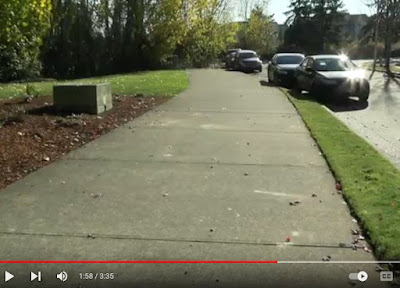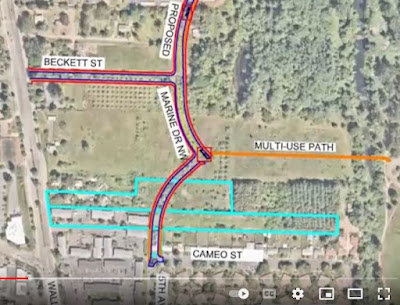The city's published another video on the bond projects. The first video, on Fisher Road, did not seem to merit comment, but this one on Marine Drive does.
 |
| City video on Marine Drive |
On Fisher Road Mayor Hoy had talked with former Director of Public Works, Peter Fernandez, and in this one he speaks with Brian Martin, whom Staff Reports at Monday's Council meeting had identified as Interim Director of Public Works. The video may have been shot and edited before the City Manager made that decision.
 |
| Also Interim Public Works Director |
Sidewalkification
They make a big deal about a 12 foot shared use path running on the east side of the roadway.
 |
| Plans for a 12 foot wide shared use path |
The sidewalkification of bicycling is a little unwelcome. The path may function acceptably when the properties are not built out, but when there are meaningful volumes of people walking, biking, and otherwise rolling on them, there will be conflicts.
 |
| NACTO: Shared use path, low walking counts only |
NACTO's "all ages and abilities" guidance recommends shared use paths only where there are few people walking.
A brand new document edition from ODOT on bikeway design highlights the potential for user conflict: "When bicycle users are directed to use a sidewalk - there are safety an operational disadvantages." It also suggests a width of 12 feet is designed for 300 users per hour - people walking, biking, and rolling - at peak.
 |
| ODOT Highway Design Manual (brand new!) |
 |
| 12 feet implies about 300 users per hour at peak |
Just wait until someone ebiking scorches at 20mph (or more!) on the path. (See BikePortland on a collision between a person on an ebike and a person on an analog bike.)
The multi-use path, and its approach to separated facilities, is not looking forward enough to electronic scooters, bikes, and other wheeled mobility. What we are going to need are separated low-impact lanes for the various forms of battery-powered micro-mobility and for human-powered cyclists who want to go faster than is appropriate on a facility shared with people strolling and walking dogs.
The City's design concepts still look backwards rather than forwards.
As we crank up the conversations around the update to the Transportation System Plan, we will want to think more about how we are deploying shared use paths. The new Strong Road at Fairview has one, proposals for Salem Heights Avenue have showed them, and now this. It looks like the City is drifting towards them as a standard in lieu of protected bike lanes (or low impact mobility lanes) inside the curb. This deserves more explicit discussion.
The initial schedule is for construction to start in 2027 with a completion date in 2028, and it seems possible the design will be outdated by then.
Development of Marine Drive Plan after SRC Halted
Also interesting is the large scale plan. Here is the current plan from the video compared with clips from 2019 during the last phase of the SRC debate.
 |
| Connects at 5th Ave with path to ballfields (Jan 2023) |
The neighborhood prevailed and successfully redirected the first connection to 5th and away from the park.
 |
| Runs along the park instead (Jan 2019) |
At the same time, neighborhood advocates argued for straightening out the alignment, and the City's plan retains the possibility of that curving section along the park edge.
 |
| May 2020 |
The north end does not go up to River Bend Road.
 |
| Terminates at Harritt Drive (Jan 2023) |
 |
| Connects to River Bend Road (Jan 2019) |
And of course, no massive bridge landing and interchange at Hope Avenue.


4 comments:
Another recent instance of the sidewalkifcation of bicycling is the plan for Commercial Street at Division/Front (blocks north and south of it). See notes here and here.
Apparently, Marine Drive does not require dedicated bike lanes. The wide sidewalks may not have been required either. Seems like a good plan whose value was recognized by the city and the developers.
For those wanting Salem to look more like certain Scandinavian countries, this would be a good first step. There are no perfect solutions. As to safety concerns, people must simply behave responsibly. Pedestrians always have the right of way.
There is no simple solution for the Ebike problem. They cannot operate safely in normal traffic lanes. They are a danger within bike lanes.
The best approach I can think of is that, within wide sidewalks such as this (which I believe "need" to be expanded throughout the city), is to limit Ebike (and skateboard) speeds in certain areas. There could even be a requirement that they be "walked", like bikes in the downtown area, when circumstances justify that limitation.
A well designed and publicized enforcement campaign, with properly placed signage, should take place as sidewalks are widened across the city.
On main streets their use may even allow for removal of on-street bike lanes. That could greatly improve our ability to improve both traffic flow and the quality and quantity of mass transit.
Please go to Harritt Drive and see how the kids leave their bikes, trikes, scooters and toys on the multiuse path now. The city is not likely to send officers to ticket the kids playing on the path. The city could build the path to the east of the apartments to make the path a usable commuter route.
Anon/AnotherVoice, you want to prioritize car travel and flow, and to inconvenience people walking and rolling. You want a pedestrian/bicycular displacement system to get them "out of the way."
Climate and safety instead calls for us to diminish, and even inconvenience at times, car travel and car speed, and instead to prioritize walking and rolling. Walking and rolling should be delightful, not made difficult and inconvenient! People on foot deserve not to have to dodge scorchers on bike.
Mark, that is interesting about kids at play near Harritt! As a glorified "sidewalk," of course kids will play on it. And they should be able to without excessive scolding, let alone policing, especially in an increasingly residential area with apartments. That is another way the shared use path is an inferior solution here.
Post a Comment